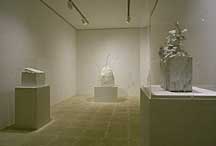In February 1995, The Menil Collection, in collaboration with the artist Cy Twombly and Dia Center for the Arts, New York, opened the Cy Twombly Gallery, an exhibition annex housing a permanent installation of Twombly’s art. Born in 1928 in Lexington, Virginia, Twombly studied art at the School of the Museum of Fine Arts, Boston (1947–49); the Art Students League, New York (1950–51); and Black Mountain College in North Carolina (1951–52). In the mid 1950s, following travels in Europe and Africa, Twombly emerged as a prominent figure among a group of artists working in New York that included Robert Rauschenberg and Jasper Johns. In 1959, Twombly settled permanently in Italy. He has had numerous one-person exhibitions internationally and has been the subject of major retrospectives in both Europe and America.
|
|
|
Twombly‘s painting combines elements of gestural abstraction, drawing, and writing in a very personal expression. At once epic and intimate, his work is infused with references to literature and aspects of the Mediterranean and Near-Eastern worlds. The building houses more than thirty of Twombly’s paintings, sculptures, and works on paper, dating from 1953 to 1994. Among these are a number of his key, large-scale masterworks such as The Age of Alexander, 1959–60, Triumph of Galatea, 1961, and the monumental painting Untitled (Say Goodbye Catallus, to the Shores of
Asia Minor), 1994.
The gallery, designed by Renzo Piano, has a sophisticated roofing system that allows for an even diffusion of natural light. An external canopy of fixed louvers first breaks the sunlight over a sloping, hipped glass roof. Passing through ultraviolet filtering glass, the light is controlled by mechanical louvers and finally dispersed within the galleries by the stretched cotton fabric ceiling.
The Cy Twombly Gallery is a joint project of The Menil Collection, Dia Center for the Arts, and the artist.
|
|






